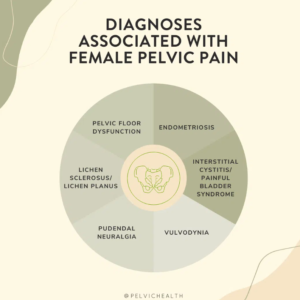What is the pelvic floor?
“The pelvic floor is 3 layers of muscles that sit at the base of the pelvis,” Molly Bachman, DPT, explained.
Are certain people more prone to pelvic floor issues?
Pelvic pain can present itself and be a little difficult to determine its origin. It’s a rather complex area that can involve various diagnoses. It’s important to seek medical advice when experiencing pelvic pain for a proper diagnosis of your exact health condition.
Pain is an active component of many health issues, which makes it vital to understand the true meaning of the Stanford Pain Scale.
“Pelvic pain dysfunction affects one in three women at some point during their lives,”* research suggests.

That means many people in your circle will experience it. Whether it be you, a sister, a mother, a friend, relative, or colleague. Pelvic floor pain knows no bounds.
What are common pelvic floor symptoms that may indicate the time for evaluation and diagnosis?
“If you are experiencing changes in your urinary function, bowel function, sexual function or are experiencing pelvic pain, the pelvic floor and pelvic girdle musculature could be involved,” Bachmann educates.
Between her strong knowledge and research findings, I wanted to uncover if there were any “target” audiences for pelvic floor problems.
Research has shown that “race, ethnicity, or level of education achieved”** make no difference in probability of pelvic floor disorders. Though it has indicated that “underweight and normal weight women [are] less likely to have a pelvic floor disorder [with the range decreasing from about 10-15%]”**
What is the pelvic floor’s role?
“The 3 layers of muscle [of the pelvic floor] are responsible for controlling urine, bowels, sexual function and supporting our organs. This means that if we develop symptoms in one of these categories, we should always consider that the pelvic floor muscles may be involved,” Bachmann continued.
The NIH states, “Pelvic floor disorders increase with age.”** A director at the NIH, Dr. Duane Alexander, stated it “underscores the need to identify the causes of pelvic floor disorders and the means to prevent and treat them.”**
What is one of the most successful treatments for pelvic floor problems?
Pelvic floor therapy.
Who is an ideal candidate for pelvic floor therapy?
While some people may be symptomatic today and know they need to seek treatment, the reality is nearly every woman can be a great candidate for pelvic floor therapy.
Why is that? Bachmann’s insight is:
“It is never too early and never too late. You do not have to have symptoms of pelvic floor dysfunction to see a pelvic floor therapist.”
There’s a benefit to being ahead of the curve, being proactive, and lessening the chance of future unpleasant, disabling symptoms. Why wait until there is a problem? Emergencies rarely occur during the perfect time. If you can carve out time this week, this month, or soon… you could be helping yourself live a healthier life and achieving a healthier body, before you have no real choice.
Let’s talk pregnancy and pelvic floor. A hot topic – and well, a frequent topic and recurring problem for pregnant women.
Pregnancy is a long and simultaneously short period of time where you’re likely to become very aware of your pelvic floor.
As we know too well, symptoms and health issues across the board are exacerbated during pregnancy.
If you’re trying to conceive or pregnant, you’re probably wondering:
- What can I do to strengthen my pelvic floor?
- Are there exercises that I can do at home?
- Who can I reach out to and trust for guidance and help?
“More and more I am seeing people who want to know what their baseline pelvic floor function is so that they can better optimize their health or want to understand their body better so that they can more effectively labor and birth a child for example,” Bachmann states.
She stated how “wonderful” this is. I couldn’t agree more.
Through educating our communities, thereby increasing knowledge, and applying techniques and solutions from a pelvic floor expert, Bachmann stated “knowing your baseline helps to create better body literacy and a sense of awareness when there is an adverse event in the pelvic floor which reduces delaying needed care.”
UT Southwestern has indicated that “by identifying pelvic floor disorders earlier and tracking their progression, doctors can prescribe preventive measures such as weight loss, a high-fiber diet, pelvic floor exercises, and smoking cessation. Long-term tracking also will allow better understanding and improve treatment.”
The best news about pelvic floor pain?
“Most states now no longer require a physician referral to see a pelvic floor therapist! This is great because it means that the power is moving back into the hands of the patients/clients,” Bachmann states.
For more information and details on pelvic pain, https://pelvicpainrehab.com/ is a great resource to tap into and share with others.
Molly Bachman, DPT, specializes in orthopedics and pelvic health. She is also certified as a birth doula. Her passion for improving individuals’ health has been proven beyond measure. She has studied public health in India, China, and South Africa; worked as a Peace Corps Volunteer in Sierra Leone during the Ebola crisis. Molly is passionate about educating the public on pelvic health and looks forward to expanding pelvic health access in the Midwest (United States).
*https://pelvicpainrehab.com/
**https://www.nih.gov/news-events/news-releases/roughly-one-quarter-us-women-affected-pelvic-floor-disorders
Watch for more from Molly Bachmann, DPT, in the coming weeks.
This website does not provide medical advice. No material on this site is intended to be a substitute for professional medical advice, diagnosis or treatment. It is for informational purposes only. Always seek the advice of a medical professional or other qualified health care provider on any health matter or question.
